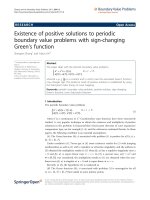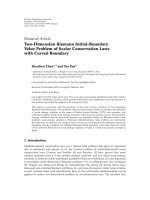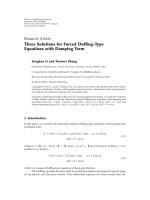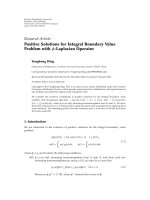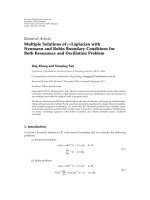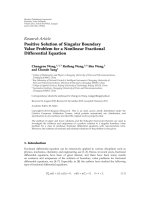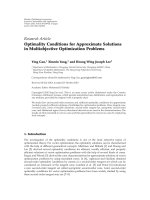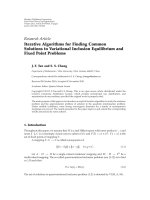Báo cáo hóa học: " Research Article Positive Solutions for Integral Boundary Value Problem with φ-Laplacian Operator Yonghong Ding" pdf
Bạn đang xem bản rút gọn của tài liệu. Xem và tải ngay bản đầy đủ của tài liệu tại đây (520.67 KB, 15 trang )
Hindawi Publishing Corporation
Boundary Value Problems
Volume 2011, Article ID 827510, 15 pages
doi:10.1155/2011/827510
Research Article
Positive Solutions for Integral Boundary Value
Problem with φ-Laplacian Operator
Yonghong Ding
Department of Mathematics, Northwest Normal University, Lanzhou 730070, China
Correspondence should be addressed to Yonghong Ding,
Received 20 September 2010; Revised 31 December 2010; Accepted 19 January 2011
Academic Editor: Gary Lieberman
Copyright q 2011 Yonghong Ding. This is an open access article distributed under the Creative
Commons Attribution License, which permits unrestricted use, distribution, and reproduction in
any medium, provided the original work is properly cited.
We consider the existence, multiplicity of positive solutions for the integral boundary value
problem with φ-Laplacian φu
t
ft, ut,u
t 0, t ∈ 0, 1, u0
1
0
urgrdr,
u1
1
0
urhrdr,whereφ is an odd, increasing homeomorphism from R onto R. We show
that it has at least one, two, or three positive solutions under some assumptions by applying fixed
point theorems. The interesting point is that the nonlinear term f is involved with the first-order
derivative explicitly.
1. Introduction
We are interested in the existence of positive solutions for the integral boundary value
problem
φ
u
t
f
t, u
t
,u
t
0,t∈
0, 1
,
u
0
1
0
u
r
g
r
dr, u
1
1
0
u
r
h
r
dr,
1.1
where φ, f, g,andh satisfy the following conditions.
H1 φ is an odd, increasing homeomorphism from R onto R, and there exist two
increasing homeomorphisms ψ
1
and ψ
2
of 0, ∞ onto 0, ∞ such that
ψ
1
u
φ
v
≤ φ
uv
≤ ψ
2
u
φ
v
∀u, v > 0. 1.2
Moreover, φ, φ
−1
∈ C
1
R, where φ
−1
denotes the inverse of φ.
2 Boundary Value Problems
H2 f : 0, 1 × 0, ∞ × −∞, ∞ → 0, ∞ is continuous. g,h ∈ L
1
0, 1 are
nonnegative, and 0 <
1
0
gtdt<1, 0 <
1
0
htdt<1.
The assumption H1 on the function φ was first introduced by Wang 1, 2, it covers
two important cases: φuu and φu|u|
p−2
u, p > 1. The existence of positive solutions
for two above cases received wide attention see 3–10. For example, Ji and Ge 4 studied
the multiplicity of positive solutions for the multipoint boundary value problem
φ
p
u
t
q
t
f
t, u
t
,u
t
0,t∈
0, 1
,
u
0
m
i1
α
i
u
ξ
i
,u
1
m
i1
β
i
u
ξ
i
,
1.3
where φ
p
s|s|
p−2
s, p>1. They provided sufficient conditions for the existence of at
least three positive solutions by using Avery-Peterson fixed point theorem. In 5, Feng et
al. researched the boundary value problem
φ
p
u
t
q
t
f
t, u
t
0,t∈
0, 1
,
u
0
m−2
i1
a
i
u
ξ
i
,u
1
m−2
i1
b
i
u
ξ
i
,
1.4
where the nonlinear term f does not depend on the first-order derivative and φ
p
s|s|
p−2
s,
p>1. They obtained at least one or two positive solutions under some assumptions imposed
on the nonlinearity of f by applying Krasnoselskii fixed point theorem.
As for integral boundary value problem, when φuu is linear, the existence of
positive solutions has been obtained see 8–10.In8, the author investigated the positive
solutions for the integral boundary value problem
u
f
u
0,
u
0
1
0
u
τ
dα
τ
,u
1
1
0
u
τ
dβ
τ
.
1.5
The main tools are the priori estimate method and the Leray-Schauder fixed point theorem.
However, there are few papers dealing with the existence of positive solutions when φ
satisfies H1 and f depends on both u and u
. This paper fills this gap in the literature. The
aim of this paper is to establish some simple criteria for the existence of positive solutions of
BVP1.1. To get rid of the difficulty of f depending on u
, we will define a special norm in
Banach space in Section 2.
This paper is organized as follows. In Section 2, we present some lemmas that are
used to prove our main results. In Section 3, the existence of one or two positive solutions for
BVP1.1 is established by applying the Krasnoselskii fixed point theorem. In Section 4,we
give the existence of three positive solutions for BVP1.1 by using a new fixed point theorem
introduced by Avery and Peterson. In Section 5, we give some examples to illustrate our main
results.
Boundary Value Problems 3
2. Preliminaries
The basic space used in this paper is a real Banach space C
1
0, 1 with norm ·
1
defined by
u
1
max{u
c
, u
c
}, where u
c
max
0≤t≤1
|ut|.Let
K
u ∈ C
1
0, 1
| u
t
≥ 0,u
1
1
0
u
t
h
t
dt, u is concave on
0, 1
. 2.1
It is obvious that K is a cone in C
1
0, 1.
Lemma 2.1 see 7. Let u ∈ K, η ∈ 0, 1/2,thenut ≥ η max
0≤t≤1
|ut|, t ∈ η, 1 − η.
Lemma 2.2. Let u ∈ K, then there exists a constant M>0 such that max
0≤t≤1
|ut|≤
Mmax
0≤t≤1
|u
t|.
Proof. The mean value theorem guarantees that there exists τ ∈ 0, 1, such that
u
1
u
τ
1
0
h
t
dt.
2.2
Moreover, the mean value theorem of differential guarantees that there exists σ ∈ τ, 1, such
that
1
0
h
t
dt − 1
u
τ
u
1
− u
τ
1 − τ
u
σ
. 2.3
So we have
|
u
t
|
≤
|
u
τ
|
t
τ
u
s
ds
≤
⎛
⎝
1 − τ
1 −
1
0
h
t
dt
1
⎞
⎠
max
0≤t≤1
u
t
≤
2 −
1
0
h
t
dt
1 −
1
0
h
t
dt
max
0≤t≤1
u
t
.
2.4
Denote M 2 −
1
0
htdt/1 −
1
0
htdt; then the proof is complete.
Lemma 2.3. Assume that (H1), (H2) hold. If u is a solution of BVP1.1, there exists a unique δ ∈
0, 1, such that u
δ0 and ut ≥ 0, t ∈ 0, 1.
Proof. From the fact that φu
−ft, ut,u
t < 0, we know that φu
t is strictly
decreasing. It follows that u
t is also strictly decreasing. Thus, ut is strictly concave on 0,
1. Without loss of generality, we assume that u0min{u0,u1}. By the concavity of
u, we know that ut ≥ u0, t ∈ 0, 1.Sowegetu0
1
0
utgtdt ≥ u0
1
0
gtdt.By
0 <
1
0
gtdt<1, it is obvious that u0 ≥ 0. Hence, ut ≥ 0, t ∈ 0, 1.
On the other hand, from the concavity of u, we know that there exists a unique δ where
the maximum is attained. By the boundary conditions and ut ≥ 0, we know that δ
/
0or1,
that is, δ ∈ 0, 1 such that uδmax
0≤t≤1
ut and then u
δ0.
4 Boundary Value Problems
Lemma 2.4. Assume that (H1), ( H2) hold. Suppose u is a solution of BVP1.1;then
u
t
1
1 −
1
0
g
r
dr
1
0
g
r
r
0
φ
−1
δ
s
f
τ,u
τ
,u
τ
dτ
ds dr
t
0
φ
−1
δ
s
f
τ,u
τ
,u
τ
dτ
ds
2.5
or
u
t
1
1 −
1
0
h
r
dr
1
0
h
r
1
r
φ
−1
s
δ
f
τ,u
τ
,u
τ
dτ
ds dr
1
t
φ
−1
s
δ
f
τ,u
τ
,u
τ
dτ
ds.
2.6
Proof. First, by integrating 1.1 on 0,t, we have
φ
u
t
φ
u
0
−
t
0
f
s, u
s
,u
s
ds,
2.7
then
u
t
φ
−1
φ
u
0
−
t
0
f
s, u
s
,u
s
ds
. 2.8
Thus
u
t
u
0
t
0
φ
−1
φ
u
0
−
s
0
f
τ,u
τ
,u
τ
dτ
ds
2.9
or
u
t
u
1
−
1
t
φ
−1
φ
u
0
−
s
0
f
τ,u
τ
,u
τ
dτ
ds.
2.10
According to the boundary condition, we have
u
0
1
1 −
1
0
g
r
dr
1
0
g
r
r
0
φ
−1
φ
u
0
−
s
0
f
τ,u
τ
,u
τ
dτ
ds dr,
u
1
−
1
1 −
1
0
h
r
dr
1
0
h
r
1
r
φ
−1
φ
u
0
−
s
0
f
τ,u
τ
,u
τ
dτ
ds dr.
2.11
Boundary Value Problems 5
By a similar argument in 5, φu
0
δ
0
fτ, uτ,u
τdτ; then the proof is completed.
Now we define an operator T by
Tu
t
⎧
⎪
⎪
⎪
⎪
⎪
⎪
⎪
⎪
⎪
⎪
⎪
⎪
⎪
⎪
⎪
⎪
⎪
⎪
⎨
⎪
⎪
⎪
⎪
⎪
⎪
⎪
⎪
⎪
⎪
⎪
⎪
⎪
⎪
⎪
⎪
⎪
⎪
⎩
1
1 −
1
0
g
r
dr
1
0
g
r
r
0
φ
−1
δ
s
f
τ,u
τ
,u
τ
dτ
ds dr
t
0
φ
−1
δ
s
f
τ,u
τ
,u
τ
dτ
ds, 0 ≤ t ≤ δ,
1
1 −
1
0
h
r
dr
1
0
h
r
1
r
φ
−1
s
δ
f
τ,u
τ
,u
τ
dτ
ds dr
1
t
φ
−1
s
δ
f
τ,u
τ
,u
τ
dτ
ds, δ ≤ t ≤ 1.
2.12
Lemma 2.5. T : K → K is completely continuous.
Proof. Let u ∈ K; then from the definition of T, we have
Tu
t
⎧
⎪
⎪
⎪
⎪
⎪
⎨
⎪
⎪
⎪
⎪
⎪
⎩
φ
−1
δ
t
f
τ,u
τ
,u
τ
dτ
≥ 0, 0 ≤ t ≤ δ,
−φ
−1
t
δ
f
τ,u
τ
,u
τ
dτ
≤ 0,δ≤ t ≤ 1.
2.13
So Tu
t is monotone decreasing continuous and Tu
δ0. Hence, Tut is
nonnegative and concave on 0, 1. By computation, we can get Tu1
1
0
Tuthtdt.This
shows that TK ⊂ K. The continuity of T is obvious since φ
−1
,f is continuous. Next, we
prove that T is compact on C
1
0, 1.
Let D be a bounded subset of K and m>0 is a constant such that
1
0
fτ,
uτ,u
τdτ<mfor u ∈ D. From the definition of T, for any u ∈ D,weget
|
Tu
t
|
<
⎧
⎪
⎪
⎪
⎪
⎪
⎨
⎪
⎪
⎪
⎪
⎪
⎩
φ
−1
m
1 −
1
0
g
r
dr
, 0 ≤ t ≤ δ,
φ
−1
m
1 −
1
0
h
r
dr
,δ≤ t ≤ 1,
Tu
t
<φ
−1
m
, 0 ≤ t ≤ 1.
2.14
Hence, TD is uniformly bounded and equicontinuous. So we have that TD is compact on
C0, 1.From2.13,weknowfor∀ε>0, ∃κ>0, such that when |t
1
− t
2
| <κ, we have
6 Boundary Value Problems
|φTu
t
1
− φTu
t
2
| <ε.SoφTD
is compact on C0, 1; it follows that TD
is compact
on C0, 1. Therefore, TD is compact on C
1
0, 1.
Thus, T : K → K is completely continuous.
It is easy to prove that each fixed point of T is a solution for BVP1.1.
Lemma 2.6 see 1. Assume that (H1) holds. Then for u, v ∈ 0, ∞,
ψ
−1
2
u
v ≤ φ
−1
uφ
v
≤ ψ
−1
1
u
v.
2.15
To obtain positive solution for BVP1.1, the following definitions and fixed point
theorems in a cone are very useful.
Definition 2.7. The map α is said to be a nonnegative continuous concave functional on a cone
of a real Banach space E provided that α : K → 0, ∞ is continuous and
α
tx
1 − t
y
≥ tα
x
1 − t
α
y
2.16
for all x, y ∈ K and 0 ≤ t ≤ 1. Similarly, we say the map γ is a nonnegative continuous convex
functional on a cone of a real Banach space E provided t hat γ : K → 0, ∞ is continuous and
γ
tx
1 − t
y
≤ tγ
x
1 − t
γ
y
2.17
for all x, y ∈ K and 0 ≤ t ≤ 1.
Let γ and θ be a nonnegative continuous convex functionals on K, α a nonnegative
continuous concave functional on K,andψ a nonnegative continuous functional on K. Then
for positive real number a, b, c,andd, we define the following convex sets:
P
γ,d
u ∈ K | γ
u
<d
,
P
γ,α,b,d
u ∈ K | α
u
≥ b, γ
u
≤ d
,
P
γ,θ,α,b,c,d
u ∈ K | α
u
≥ b, θ
u
≤
c, γ
u
≤ d
,
R
γ,ψ,a,d
u ∈ K | ψ
u
≥ a, γ
u
≤ d
.
2.18
Theorem 2.8 see 11. Let E be a real Banach space and K ⊂ E a cone. Assume that Ω
1
and Ω
2
are t wo bounded open sets in E with 0 ∈ Ω
1
, Ω
1
⊂ Ω
2
.LetT : K ∩ Ω
2
\ Ω
1
→ K be completely
continuous. Suppose that one of following two conditions is satisfied:
1 Tu≤u, u ∈ K ∩ ∂Ω
1
, and Tu≥u, u ∈ K ∩ ∂Ω
2
;
2 Tu≥u, u ∈ K ∩ ∂Ω
1
, and Tu≤u, u ∈ K ∩ ∂Ω
2
.
Then T has at least one fixed point in
Ω
2
\ Ω
1
.
Theorem 2.9 see 12. Let K be a cone in a real Banach space E.Letγ and θ be a nonnegative
continuous convex functionals on K, α a nonnegative continuous concave functional on K, and ψ
Boundary Value Problems 7
a nonnegative continuous functional on K satisfying ψλu ≤ λψu for 0 ≤ λ ≤ 1, such that for
positive number M and d,
α
u
≤ ψ
u
, u≤Mγ
u
2.19
for all u ∈
Pγ,d. Suppose T : P γ,d → Pγ,d is completely continuous and there exist positive
numbers a, b, and c with a<bsuch that
S1 {u ∈ Pγ,θ,α,b,c,d | αu >b}
/
∅ and αTu >bfor u ∈ P γ,θ,α,b,c,d;
S2 αTu >bfor u ∈ P γ,α,b,d with θTu >c;
S3 0 /∈ Rγ,ψ,a,d and ψTu <afor u ∈ Rγ,ψ,a,d with ψua.
Then T has at least three fixed points u
1
,u
2
,u
3
∈ Pγ,d, such that
γu
i
≤ d for i 1, 2, 3,
αu
1
>b,
ψu
2
>awith αu
2
<b,
ψu
3
<a.
3. The Existence of One or Two Positive Solutions
For convenience, we denote
L max
⎧
⎨
⎩
1
0
ψ
−1
1
1 − s
ds
1 −
1
0
g
s
ds
, 1
⎫
⎬
⎭
,N min
1/2
0
ψ
−1
2
1
2
− s
ds,
1
1/2
ψ
−1
2
s −
1
2
ds
,
f
μ
lim sup
u
c
v
c
→ μ
max
t∈0,1
f
t, u
t
,v
t
φ
u
c
v
c
,f
μ
lim inf
u
c
v
c
→ μ
min
t∈0,1
f
t, u
t
,v
t
φ
u
c
v
c
,
3.1
where μ denotes 0 or ∞.
Theorem 3.1. Assume that (H1) and (H2) hold. In addition, suppose that one of following conditions
is satisfied.
i There exist two constants r, R with 0 <r<N/LR such that
a ft, u, v ≥ φr/N for t, u, v ∈ 0, 1 × 0,r × −r, r and
b ft, u, v ≤ φR/L for t, u, v ∈ 0, 1 × 0,R × −R, R;
ii f
∞
<ψ
1
1/2L,f
0
>ψ
2
1/N;
iii f
0
<ψ
1
1/2L,f
∞
>ψ
2
1/N.
Then BVP1.1 has at least one positive solution.
8 Boundary Value Problems
Proof. i Let Ω
1
{u ∈ K |u
1
<r}, Ω
2
{u ∈ K |u
1
<R}.
For u ∈ ∂Ω
1
,weobtainu ∈ 0,r and u
∈ −r, r, which implies ft, u, u
≥ φr/N.
Hence, by 2.12 and Lemma 2.6,
Tu
c
max
0≤t≤1
|
Tu
t
|
1
1 −
1
0
g
r
dr
1
0
g
r
r
0
φ
−1
δ
s
f
τ,u
τ
,u
τ
dτ
ds dr
δ
0
φ
−1
δ
s
f
τ,u
τ
,u
τ
dτ
ds
1
1 −
1
0
h
r
dr
1
0
h
r
1
r
φ
−1
s
δ
f
τ,u
τ
,u
τ
dτ
ds dr
1
δ
φ
−1
s
δ
f
τ,u
τ
,u
τ
dτ
ds
≥ min
⎧
⎨
⎩
1
1 −
1
0
g
r
dr
1
0
g
r
r
0
φ
−1
δ
s
f
τ,u
τ
,u
τ
dτ
ds dr
1/2
0
φ
−1
1/2
s
f
τ,u
τ
,u
τ
dτ
ds,
1
1 −
1
0
h
r
dr
1
0
h
r
1
r
φ
−1
s
δ
f
τ,u
τ
,u
τ
dτ
ds dr
1
1/2
φ
−1
s
1/2
f
τ,u
τ
,u
τ
dτ
ds
≥ min
1/2
0
φ
−1
1/2
s
f
τ,u
τ
,u
τ
dτ
ds,
1
1/2
φ
−1
s
1/2
f
τ,u
τ
,u
τ
dτ
ds
≥ min
1/2
0
φ
−1
φ
r
N
1
2
− s
ds,
1
1/2
φ
−1
φ
r
N
s −
1
2
ds
≥
r
N
min
1/2
0
ψ
−1
2
1
2
− s
ds,
1
1/2
ψ
−1
2
s −
1
2
ds
r
u
1
.
3.2
This implies that
Tu
1
≥
u
1
for u ∈ ∂Ω
1
. 3.3
Boundary Value Problems 9
Next, for u ∈ ∂Ω
2
, we have ft, u, v ≤ φR/L.Thus,by2.12 and Lemma 2.6,
Tu
c
max
0≤t≤1
|
Tu
t
|
≤
1
1 −
1
0
g
r
dr
1
0
g
r
1
0
φ
−1
1
s
f
τ,u
τ
,u
τ
dτ
ds dr
1
0
φ
−1
1
s
f
τ,u
τ
,u
τ
dτ
ds
≤
1
1 −
1
0
g
r
dr
1
0
φ
−1
1 − s
φ
R
L
ds
≤
R
L
1
0
ψ
−1
1
1 − s
ds
1 −
1
0
g
r
dr
≤ R
u
1
.
3.4
From 2.13, we have
Tu
c
max
φ
−1
δ
0
f
τ,u
τ
,u
τ
dτ
,φ
−1
1
δ
f
τ,u
τ
,u
τ
dτ
≤ φ
−1
1
0
f
τ,u
τ
,u
τ
dτ
≤ φ
−1
φ
R
L
≤ R
u
1
.
3.5
This implies that
Tu
1
≤
u
1
for u ∈ ∂Ω
2
. 3.6
Therefore, by Theorem 2.8, it follows that T has a fixed point in
Ω
2
\ Ω
1
. That is BVP1.1 has
at least one positive solution such that 0 <r≤u
1
≤ R.
ii Considering f
∞
<ψ
1
1/2L, there exists ρ
0
> 0 such that
f
t, u, v
≤ ψ
1
1
2L
φ
u
c
v
c
for t ∈
0, 1
,
u
c
v
c
≥ 2ρ
0
. 3.7
Choosing
M>ρ
0
such that
max
f
t, u, v
|
u
c
v
c
≤ 2ρ
0
≤ ψ
1
1
2L
φ
M
, 3.8
10 Boundary Value Problems
then for all ρ>
M,letΩ
3
{u ∈ K |u
1
<ρ}. For every u ∈ ∂Ω
3
, we have u
c
u
c
≤ 2ρ.
In the following, we consider two cases.
Case 1 u
c
u
c
≤ 2ρ
0
. In this case,
f
t, u, u
≤ ψ
1
1
2L
φ
M
≤ φ
M
2L
≤ φ
ρ
L
. 3.9
Case 2 2ρ
0
≤u
c
u
c
≤ 2ρ. In this case,
f
t, u, u
≤ ψ
1
1
2L
φ
u
c
u
c
≤ ψ
1
1
2L
φ
2ρ
≤ φ
ρ
L
. 3.10
Then it is similar to the proof of 3.6; we have Tu
1
≤u
1
for u ∈ ∂Ω
3
.
Next, turning to f
0
>ψ
2
1/N, there exists 0 <ξ<ρsuch that
f
t, u, v
≥ ψ
2
1
N
φ
u
c
v
c
for t ∈
0, 1
,
u
c
v
c
≤ 2ξ. 3.11
Let Ω
4
{u ∈ K |u
1
<ξ}. For every u ∈ ∂Ω
4
, we have u
c
u
c
≤ 2ξ.So
f
t, u, u
≥ ψ
2
1
N
φ
u
c
u
c
≥ ψ
2
1
N
φ
u
1
≥ φ
ξ
N
.
3.12
Then like in the proof of 3.3, we have Tu
1
≥u
1
for u ∈ ∂Ω
4
. Hence, BVP1.1 has at least
one positive solution such that 0 <ξ≤u
1
≤ ρ.
iii The proof is similar to the i and ii; here we omit it.
In the following, we present a result for the existence of at least two positive solutions
of BVP1.1.
Theorem 3.2. Assume that (H1) and (H2) hold. In addition, suppose that one of following conditions
is satisfied.
I f
0
<ψ
1
1/2L, f
∞
<ψ
1
1/2L, and there exists m
1
> 0 such that
f
t, u, v
≥ φ
m
1
N
for t ∈
0, 1
,m
1
≤
u
c
v
c
≤ 2m
1
; 3.13
II f
0
>ψ
2
1/N, f
∞
>ψ
2
1/N, and there exists m
2
> 0 such that
f
t, u, v
≤ φ
m
2
L
for t ∈
0, 1
,
u
c
v
c
≤ 2m
2
. 3.14
Then BVP1.1 has at least two positive solutions.
Boundary Value Problems 11
4. The Existence of Three Positive Solutions
In this section, we impose growth conditions on f which allow us to apply Theorem 2.9 of
BVP1.1.
Let t he nonnegative continuous concave functional α, the nonnegative continuous
convex functionals γ, θ, and nonnegative continuous functional ψ be defined on cone K by
γ
u
max
0≤t≤1
u
t
,ψ
u
θ
u
max
0≤t≤1
|
u
t
|
,α
u
min
η≤t≤1−η
|
u
t
|
.
4.1
By Lemmas 2.1 and 2.2, the functionals defined above satisfy
ηθ
u
≤ α
u
≤ ψ
u
θ
u
,
u
1
max
γ
u
,θ
u
≤ Mγ
u
, 4.2
for all u ∈ K. Therefore, the condition 2.19 of Theorem 2.9 is satisfied.
Theorem 4.1. Assume that (H1) and (H2) hold. Let 0 <a<b≤ dη/11−
1
0
htdt/
1
0
ht1−
tdt and suppose that f satisfies the following conditions:
P1 ft, u, v ≤ φd for t, u, v ∈ 0, 1 × 0,Md × −d, d;
P2 ft, u, v >φb/ηK for t, u, v ∈ η, 1 − η × b, b/η1 1 −
1
0
htdt/
1
0
ht1 −
tdt × −d, d.
P3 ft, u, v <φa/L for t, u, v ∈ 0, 1 × 0,a × −d, d;
Then BVP1.1 has at least three positive solutions u
1
,u
2
, and u
3
satisfying
max
0≤t≤1
u
i
t
≤ d for i 1, 2, 3, min
η≤t≤1−η
|
u
1
t
|
>b,
max
0≤t≤1
|
u
2
t
|
>a with min
η≤t≤1−η
|
u
2
t
|
<b, max
0≤t≤1
|
u
3
t
|
<a,
4.3
where L defined as 3.1, K min{
1/2
η
ψ
−1
2
1/2 − sds,
1−η
1/2
ψ
−1
2
s − 1/2ds}.
Proof. We will show that all the conditions of Theorem 2.9 are satisfied.
If u ∈
Pγ,d, then γumax
0≤t≤1
|u
t|≤d.WithLemma 2.2 implying
max
0≤t≤1
|ut|≤Md,sobyP1, we have ft, ut,u
t ≤ φd when 0 ≤ t ≤ 1. Thus
γ
Tu
max
0≤t≤1
Tu
t
max
φ
−1
δ
0
f
τ,u
τ
,u
τ
dτ
,φ
−1
1
δ
f
τ,u
τ
,u
τ
dτ
≤ φ
−1
1
0
f
τ,u
τ
,u
τ
dτ
≤ φ
−1
φ
d
d.
4.4
This proves that T :
Pγ,d → Pγ,d.
12 Boundary Value Problems
To check condition S1 of Theorem 2.9, we choose
u
0
t
b
η
b
1 −
1
0
h
t
dt
η
1
0
h
t
1 − t
dt
1 − t
, 0 ≤ t ≤ 1. 4.5
Let
c
b
η
⎛
⎝
1
1 −
1
0
h
t
dt
1
0
h
t
1 − t
dt
⎞
⎠
. 4.6
Then u
0
t ∈ Pγ,θ,α,b,c,d and αu
0
>b,so{u ∈ Pγ,θ,α,b,c,d | αu >b}
/
∅. Hence,
for u ∈ Pγ,θ,α,b,c,d, there is b ≤ ut ≤ c, |u
t|≤d when η ≤ t ≤ 1 − η. From assumption
P2, we have
f
t, u
t
,u
t
>φ
b
ηK
for t ∈
η, 1 − η
.
4.7
It is similar to the proof of assumption i of Theorem 3.1; we can easily get that
α
Tu
min
η≤t≤1−η
|
Tu
t
|
≥ η max
0≤t≤1
|
Tu
t
|
>b for u ∈ P
γ,θ,α,b,c,d
.
4.8
This shows that condition S1 of Theorem 2.9 is satisfied.
Secondly, for u ∈ Pγ,α,b,d with θTu >c, we have
α
Tu
≥ ηθ
Tu
≥ ηc > b. 4.9
Thus condition S2 of Theorem 2.9 holds.
Finally, as ψ00 <a, there holds 0 /∈ Rγ,ψ,a,d. Suppose that u ∈ Rγ,ψ,a,d with
ψua; then by the assumption P3,
f
t, u
t
,u
t
<φ
a
L
for t ∈
0, 1
.
4.10
So like in the proof of assumption i of Theorem 3.1, we can get
ψ
Tu
max
0≤t≤1
|
Tu
t
|
<a. 4.11
Hence condition S3 of Theorem 2.9 is also satisfied.
Boundary Value Problems 13
Thus BVP1.1 has at least three positive solutions u
1
,u
2
,andu
3
satisfying
max
0≤t≤1
u
i
t
≤ d for i 1, 2, 3, min
η≤t≤1−η
|
u
1
t
|
>b,
max
0≤t≤1
|
u
2
t
|
>a with min
η≤t≤1−η
|
u
2
t
|
<b, max
0≤t≤1
|
u
3
t
|
<a.
4.12
5. Examples
In this section, we give three examples as applications.
Example 5.1. Let φu|u|u, gtht1/2. Now we consider the BVP
φ
u
f
t, u
t
,u
t
0,t∈
0, 1
,
u
0
1
2
1
0
u
t
dt, u
1
1
2
1
0
u
t
dt,
5.1
where ft, u, v1 t18 u4 cos v for t, u, v ∈ 0, 1 × 0, ∞ × −∞, ∞.
Let ψ
1
uψ
2
uu
2
, u>0. Choosing r 1,R 100. By calculations we obtain
L
4
3
,N
2
3
1
2
3/2
,φ
r
N
18,φ
R
L
75
2
.
5.2
For t, u, v ∈ 0, 1 × 0, 1 × −1, 1,
f
t, u, v
1 t
18 u
4 cos v
≥ 18 × 4 > 18,
5.3
for t, u, v ∈ 0, 1 × 0, 100 × −100, 100,
f
t, u, v
1 t
18 u
4 cos v
≤
2 × 118 × 5 < 75
2
.
5.4
Hence, by Theorem 3.1,BVP5.1 has at least one positive solution.
Example 5.2. Let φuu, gtht1/2. Consider the BVP
φ
u
f
t, u
t
,u
t
0,t∈
0, 1
,
u
0
1
2
1
0
u
t
dt, u
1
1
2
1
0
u
t
dt,
5.5
where ft, u, v1 t1/10 u1/100 v
2
1 u
c
v
c
2
for t, u, v ∈ 0, 1 × 0, ∞×
−∞, ∞.
14 Boundary Value Problems
Let ψ
1
uψ
2
uu, u>0. Then L 1,N 1/8. It easy to see
f
0
f
∞
∞ >ψ
2
1
N
8. 5.6
Choosing m
2
1/10, for t ∈ 0, 1, u
c
v
c
≤ 2m
2
.
f
t, u, v
1 t
1
10
u
1
100
v
2
1
u
c
v
c
2
≤ 2
1
10
1
5
1
100
1
25
1
1
25
.
39
1250
<
1
10
φ
m
2
L
.
5.7
Hence, by Theorem 3.2,BVP5.5 has at least two positive solutions.
Example 5.3. Let φu|u|u, gtht1/2; consider the boundary value problem
u
u
f
t, u
t
,u
t
0,t∈
0, 1
,
u
0
u
1
1
2
1
0
u
t
dt,
5.8
where
f
t, u, v
⎧
⎪
⎪
⎪
⎨
⎪
⎪
⎪
⎩
sin t
10
4
2500u
6
1
10
4
v
10
5
3
,u≤ 12,
sin t
10
4
2500 · 12
6
1
10
4
v
10
5
3
,u>12.
5.9
Choosing a 1/10, b 1, η 1/4, d 10
5
, then by calculations we obtain that
L
4
3
,K
2
3
1
4
3/2
,φ
b
ηK
2304,φ
a
L
9
1600
.
5.10
It is easy to check that
f
t, u, v
<φ
d
10
10
for 0 ≤ t ≤ 1, 0 ≤ u ≤ 3 · 10
5
, −10
5
≤ v ≤ 10
5
,
f
t, u, v
> 2304 for
1
4
≤ t ≤
3
4
, 1 ≤ u ≤ 12, −10
5
≤ v ≤ 10
5
,
f
t, u, v
<
9
1600
for 0 ≤ t ≤ 1, 0 ≤ u ≤
1
10
, −10
5
≤ v ≤ 10
5
.
5.11
Boundary Value Problems 15
Thus, according to Theorem 4.1,BVP5.8 has at least three positive solutions u
1
,u
2
,andu
3
satisfying
max
0≤t≤1
u
i
t
≤ 10
5
for i 1, 2, 3, min
1/4≤t≤3/4
|
u
1
t
|
> 1,
max
0≤t≤1
|
u
2
t
|
>
1
10
with min
1/4≤t≤3/4
|
u
2
t
|
< 1, max
0≤t≤1
|
u
3
t
|
<
1
10
.
5.12
Acknowledgments
The research was supported by NNSF of China 10871160, the NSF of Gansu Province
0710RJZA103, and Project of NWNU-KJCXGC-3-47.
References
1 H. Wang, “On the number of positive solutions of nonlinear systems,” Journal of Mathematical Analysis
and Applications, vol. 281, no. 1, pp. 287–306, 2003.
2 H. Wang, “On the structure of positive radial solutions for quasilinear equations in annular domains,”
Advances in Differential Equations, vol. 8, no. 1, pp. 111–128, 2003.
3 J. Wang, “The existence of positive solutions for the one-dimensional p-Laplacian,” Proceedings of the
American Mathematical Society, vol. 125, no. 8, pp. 2275–2283, 1997.
4 D. Ji and W. Ge, “Multiple positive solutions for some p-Laplacian boundary value problems,” Applied
Mathematics and Computation, vol. 187, no. 2, pp. 1315–1325, 2007.
5 H. Feng, W. Ge, and M. Jiang, “Multiple positive solutions for m-point boundary-value problems with
a one-dimensional p-Laplacian,” Nonlinear Analysis: Theory, Methods & Applications, vol. 68, no. 8, pp.
2269–2279, 2008.
6 B. Liu, “Positive solutions of three-point boundary value problems for the one-dimensional p-
Laplacian with infinitely many singularities,” Applied Mathematics Letters, vol. 17, no. 6, pp. 655–661,
2004.
7 Z. Wang and J. Zhang, “Positive solutions for one-dimensional p-Laplacian boundary value problems
with dependence on the first order derivative,” Journal of Mathematical Analysis and Applications , vol.
314, no. 2, pp. 618–630, 2006.
8 Z. Yang, “Existence and uniqueness of positive solutions for an integral boundary value problem,”
Nonlinear Analysis: Theory, Methods & Applications, vol. 69, no. 11, pp. 3910–3918, 2008.
9 L. Kong, “Second order singular boundary value problems with integral boundary conditions,”
Nonlinear Analysis: Theory, Methods & Applications, vol. 72, no. 5, pp. 2628–2638, 2010.
10 A. Boucherif, “Second-order boundary value problems with integral boundary conditions,” Nonlinear
Analysis: Theory, Methods & Applications, vol. 70, no. 1, pp. 364–371, 2009.
11 D. J. Guo and V. Lakshmikantham, Nonlinear Problems in Abstract Cones, vol. 5 of Notes and Reports in
Mathematics in Science and Engineering, Academic Press, Boston, Mass, USA, 1988.
12 R. I. Avery and A. C. Peterson, “Three positive fixed points of nonlinear operators on ordered Banach
spaces,” Computers & Mathematics with Applications, vol. 42, no. 3–5, pp. 313–322, 2001.
